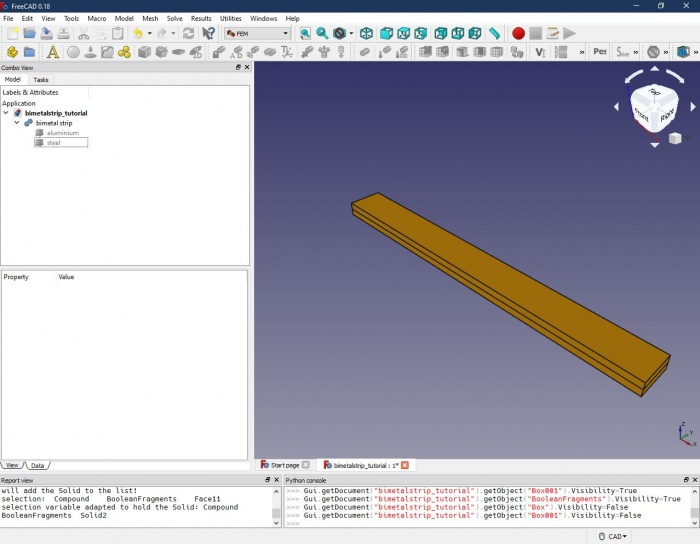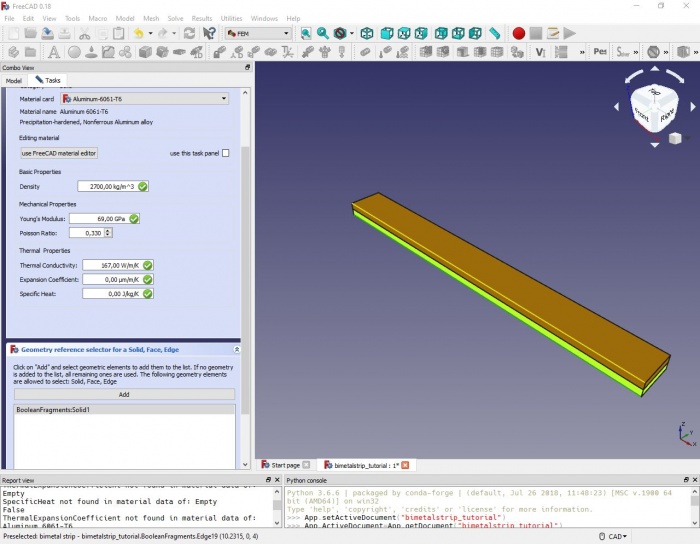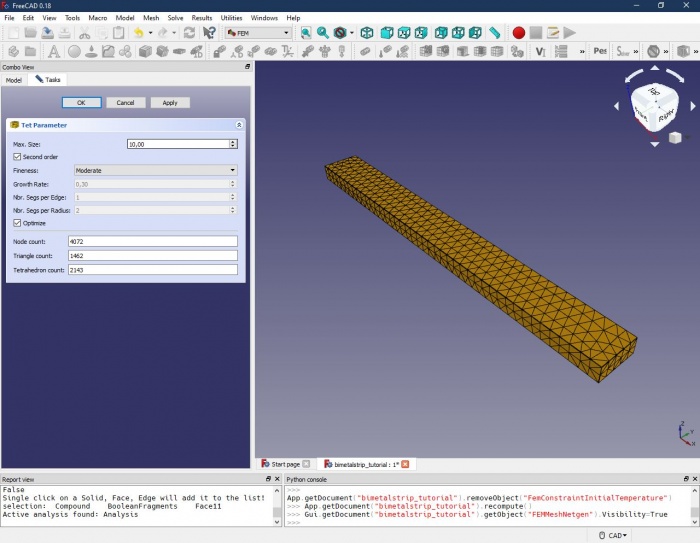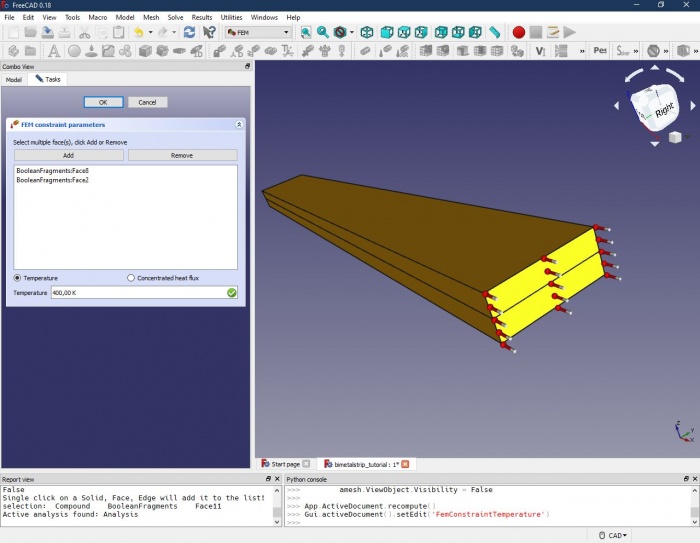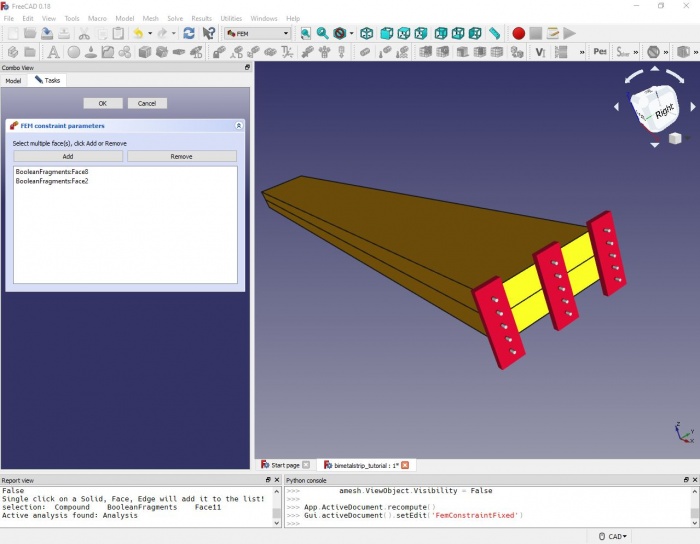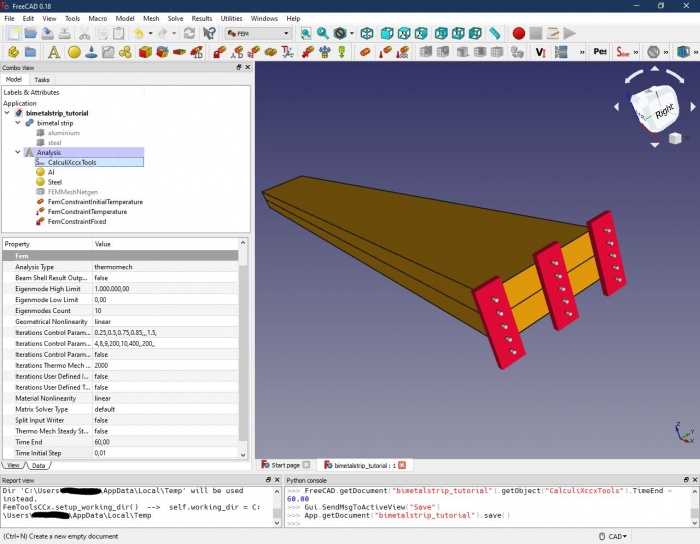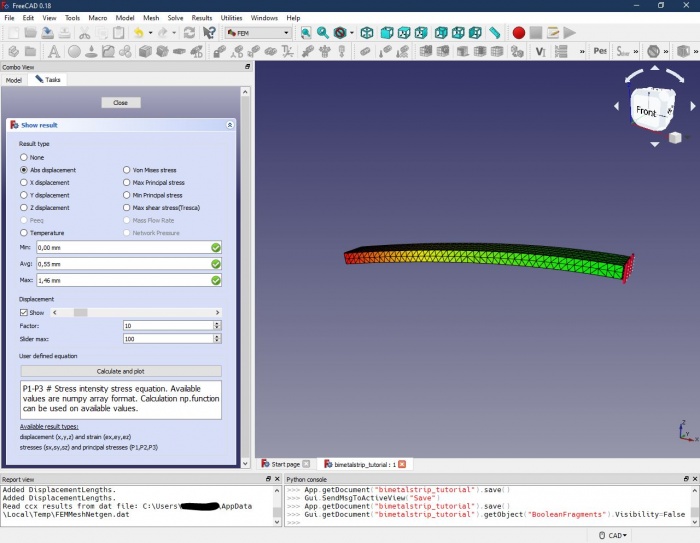Transient FEM analysis/pl: Difference between revisions
(Created page with "* [https://forum.freecadweb.org/viewtopic.php?f=18&t=43040&start=10#p366664 Analityczny przykład bimetalu]. Przykład analityczny przedstawiony na forum jest zawarty w przykładach FreeCAD FEM. Można go uruchomić w Pythonie za pomocą: from femexamples.thermomech_bimetall import setup setup()") |
(Created page with "# Zaczynając od pustego projektu FreeCAD, budujemy naszą listwę bimetaliczną w środowisku pracy 24px Część # Narysuj 24px Sześcian i zmień jego nazwę na {{incode|aluminium}}. # Nadaj temu elementowi wymiary 100 x 10 x 2 mm ''(długość x szerokość x wysokość)''. # Utwórz drugą bryłę sześcianu '''stal''' o takich samych wymiarach # Przesuń tę c...") |
||
| Line 17: | Line 17: | ||
==Tworzenie modelu== |
==Tworzenie modelu== |
||
# |
# Zaczynając od pustego projektu FreeCAD, budujemy naszą listwę bimetaliczną w środowisku pracy [[Image:Workbench_Part.svg|24px]] [[Part_Workbench/pl|Część]] |
||
# |
# Narysuj [[File:Part_Box.svg|24px]] [[Part_Box/pl|Sześcian]] i zmień jego nazwę na {{incode|aluminium}}. |
||
# |
# Nadaj temu elementowi wymiary 100 x 10 x 2 mm ''(długość x szerokość x wysokość)''. |
||
# Utwórz drugą bryłę [[Part_Box/pl|sześcianu]] '''stal''' o takich samych wymiarach |
|||
# Create a second [[Part Box|Cube]] Solid 'steel' with the same dimensions |
|||
# |
# Przesuń tę część o 2 mm wzdłuż osi Z ''(za pomocą {{MenuCommand|Edycja ... → Umiejscowienie → Pozycja → Z}})''. |
||
# |
# Zaznacz obie bryły ''(używając klawisza {{KEY|Shift}} + kliknięcie myszą)'' i utwórz z nich obiekt funkcją [[Image:Part_BooleanFragments.svg|24px]] [[Part_BooleanFragments/pl|Fragmentacja]]. |
||
# |
# Zmień nazwę obiektu Boolean Fragments na {{incode|bimetal strip}}. |
||
# |
# W [[Property_editor/pl|Edytorze właściwości]] zmieniamy tryb z {{PropertyView|Standard}} na {{PropertyView|CompSolid}}. ''(Powinno też zadziałać użycie polecenia [[Part_Compound/pl|Utwórz kształt złożony]] zamiast [[Image:Part_BooleanFragments.svg|24px]] [[Part BooleanFragments/pl|Fragmentacji funkcją logiczną]], jednak w przypadku bardziej złożonych przecinających się kształtów mogą wystąpić problemy z późniejszą analizą MES. Lepiej więc przyzwyczaić się do używania w pierwszej kolejności Fragmentacji funkcją logiczną)''. Wynik powinien wyglądać następująco: |
||
[[File:Transient FEM Bimetal (1).JPG|700px]] |
[[File:Transient FEM Bimetal (1).JPG|700px]] |
||
Revision as of 11:09, 17 November 2023
Ta dokumentacja nie jest ukończona. Prosimy o pomoc w tworzeniu dokumentacji.
Strona Model polecenia GUI wyjaśnia jak powinny być dokumentowane polecenia. Przejrzyj stronę Category:UnfinishedDocu, aby zobaczyć więcej niekompletnych stron, takich jak ta. Zobacz stronę Category:Command Reference aby poznać wszystkie komendy.
Zobacz stronę wytycznych Wikidla FreeCAD aby dowiedzieć się, jak edytować strony Wiki, i przejdź do strony Pomóż w rozwoju FreeCAD, aby dowiedzieć się o innych sposobach, w jakie możesz wnieść swój wkład.
| Temat |
|---|
| Przejściowa analiza MES |
| Poziom trudności |
| Czas wykonania |
| Autorzy |
| Wersja FreeCAD |
| Pliki z przykładami |
| Zobacz również |
| - |
Kontekst
Tworzenie modelu
- Zaczynając od pustego projektu FreeCAD, budujemy naszą listwę bimetaliczną w środowisku pracy
Część
- Narysuj
Sześcian i zmień jego nazwę na
aluminium. - Nadaj temu elementowi wymiary 100 x 10 x 2 mm (długość x szerokość x wysokość).
- Utwórz drugą bryłę sześcianu stal o takich samych wymiarach
- Przesuń tę część o 2 mm wzdłuż osi Z (za pomocą Edycja ... → Umiejscowienie → Pozycja → Z).
- Zaznacz obie bryły (używając klawisza Shift + kliknięcie myszą) i utwórz z nich obiekt funkcją
Fragmentacja.
- Zmień nazwę obiektu Boolean Fragments na
bimetal strip. - W Edytorze właściwości zmieniamy tryb z WIDOKStandard na WIDOKCompSolid. (Powinno też zadziałać użycie polecenia Utwórz kształt złożony zamiast
Fragmentacji funkcją logiczną, jednak w przypadku bardziej złożonych przecinających się kształtów mogą wystąpić problemy z późniejszą analizą MES. Lepiej więc przyzwyczaić się do używania w pierwszej kolejności Fragmentacji funkcją logiczną). Wynik powinien wyglądać następująco:
Preparing and running the FEM analysis
Assigning the materials
In the FEM workbench we create a new analysis and add a new
material to the analysis. In the upcoming task window, we select one of the predefined aluminium alloys. Under 'geometry reference selector', we assign the material to the lower strip of our model by setting the selection mode to 'solid', clicking 'add' and selecting a face or an edge of the lower strip. In the list view, 'BooleanFragments:Solid1' should show up.
We close the task window and repeat the steps to create a second material 'Steel' (material card 'CalculiX-Steel') and assign it to the top strip ('BooleanFragments:Solid2').
Creating the mesh
Since a Finite Element Analysis obviously needs elements to work with, we have to dissect our model into a so-called mesh. The FEM workbench offers two meshing tools: Netgen and GMSH. We will go with Netgen here: With the Boolean Fragments objects 'bimetal strip' selected, we click on the Netgen icon in the FEM workbench. In the upcoming task window, we have to make different selections, starting from the top:
- Max. size is the maximum size (in millimetres) of an element. The smaller the maximum element size, the more elements we get – usually the result will get more precise, but with a dramatic increase in computing time. We set it to 10.
- Second order means, that in each element, additional nodes will be created. This increases computing time, but is usually a good choice if it comes to bending as in our analysis. We leave it checked.
- Fineness: Select, how finely the model should be cut into elements. For more complex models with curvatures and intersections, we can increase the element number in those regions to get better results (at the cost of more computing time, of course). Expert users can also set it to User-defined and set the following parameters. For our simple rectangular model, the fineness selection has not much of an impact, we keep it at moderate level.
- Optimize: Some kind of post-processing after meshing. We keep it checked.
A click on 'Apply' runs the mesher, and – the time depending on your computer – a wireframe appears on our model. The mesher should have created about 4,000 nodes.
Assigning boundary conditions
An FEM analysis now would result in nothing, because nothing is happening to our model yet. So let’s add some temperature: Use the initial temperature from the FEM workbench and set the temperature to 300 K. Here, no parts of the model can be selected, since this setting applies to the complete model.
Next, we use temperature acting on a face. We select the two faces at one end of the strip (Ctrl + Left mouse key) and click 'add' in the task window. Two faces of the Boolean Fragments object should appear in the list and little temperature icons on the model. We set the temperature to 400 K and close the task window. At the beginning of the analysis, the selected faces will get an instantaneous temperature rise from 300 to 400 K. The heat will be conducted along the metal strips and cause the bending of the strip.
Before we can run the analysis, an additional boundary condition has to be set: The analysis can only run, if our model is fixed somewhere in space. With we select the same two faces as for the 400 K above, and add them to the list. Red bars will appear on the model, visualising that those faces are fixed in space and not able to move around during the analysis.
Running the analysis
The analysis should already contain a solver object 'CalculiXccx Tools'. If not, we add one by using the solver icon from the toolbar. (There are two identical icons, the experimental solver should also work.) The solver object has a list of properties below in the left section of the window. Here we select the following options (leave the ones unmentioned unchanged):
- Analysis Type: We want to run a thermomechanical analysis. Other options would be only static (no temperature effects), frequency (oscillations), or only to check the model validity.
- Thermo Mech Steady State: Steady state means, the solver will return one single result with the physics reaching equilibrium. We do NOT want to do that, we would like to get multiple, time-resolved results (transient analysis). So set it to false.
- Time end: We would like our analysis to stop after 60 seconds (i.e., simulation time, not real time).
After double-clicking the solver object, we check that 'thermomechanical' is selected and run 'write .inp file'. This usually takes some seconds (or a lot more for bigger models) and returns a message 'write completed' in the box below. Now we start the calculation with 'run CalculiX'. After some time, the last messages 'CalculiX done without error!' and 'Loading result sets...' should appear. When the timer at the bottom has stopped, we close the task window. (With larger models and/or slower computers, FreeCAD may freeze and we won’t see the timer running. But be patient, in most of the cases, CalculiX is still running in the background and will eventually produce results.)
We should now have multiple FEM result objects listed. By double-clicking, we can open each one of it and visualise the calculated temperatures, displacements, and stresses. We can visualise the bending by selecting 'Show' in the 'Displacement' section. Since the absolute displacements are small, we use the 'Factor' to exaggerate the values.
Within FreeCAD, we can use pipelines to do some post-processing of the results. Alternatively, we can export the results in the VTK format and import them into dedicated post-processors like ParaView. For the export of multiple results (as for this analysis), there is a macro available.
Pobieranie
Inny przykład
- Analityczny przykład bimetalu. Przykład analityczny przedstawiony na forum jest zawarty w przykładach FreeCAD FEM. Można go uruchomić w Pythonie za pomocą:
from femexamples.thermomech_bimetall import setup setup()
- Materiał: Bryła, Ciecz, Nieliniowy materiał mechaniczny, Materiał zbrojony (beton), Edytor materiału
- Geometria elementu: Geometria elementu, Obrót w okół osi, Geometria elementu 2D, Element przepływu
Wiązania
- Elektromagnetyczne: Potencjał elektryczny, Gęstość prądu, Magnetyzacja
- Geometryczne: Obrót w płaszczyźnie, Zapis wyników z przekroju, Zdefiniuj odkształcenie
- Mechaniczne: Zdefiniuj przytwierdzenie, Zdefiniuj przemieszczenie, Zdefiniuj kontakt, Zdefiniuj powiązanie, Wiązanie sprężyny, Zdefiniuj siłę, Zdefiniuj obciążenie ciśnieniem, Zdefiniuj siłę odśrodkową, Zdefiniuj obciążenie ciężarem własnym
- Termiczne: Warunek początkowy temperatury, Zdefiniuj strumień ciepła, Zdefiniuj temperaturę, Zdefiniuj objętościowe źródło ciepła
- Zmieniające wiązania: Zdefiniuj przenikalność elektryczną próżni
- Siatki: Siatka Netgen, Siatka GMSH, Warstwa graniczna siatki, Obszar siatki, Grupa siatki, Utwórz zestaw węzłów, Siatka MES na obiekt środowiska Siatka
- Solver: Narzędzia CalculiX, Elmer, Mystran, Z88; Równania: Elastyczności, Elektrostatyczne, Siły elektrostatycznej, Magnetodynamiczne, RMagnetodynamiczne 2D, Przepływu, Strumienia, Ciepła; Solver: Kontrola pracy solvera, Uruchom solver
- Wyniki: Oczyszczanie z wyników, Prezentacja wyników; Postprocessing: Zastosuj zmiany, Prezentacja graficzna, Filtr rozpraszający, Skalarny filtr obcinający, Filtr odcięcia funkcji, Filtr odcięcia obszaru, Filtr konturów, Filtr danych wzdłuż linii, Wykres liniowości naprężeń, Filtr obcinania danych w punkcie, Utwórz funkcję, Filtr funkcji płaszczyzny, Filtr funkcji sfery, Filtr funkcji walca, Filtr funkcji prostopadłościanu
- Dodatkowe: Konfiguracja, Instalacja środowiska MES, Siatka, FEM Solver, CalculiX, Beton, Rodzaje elementów
- Jak zacząć
- Instalacja: Pobieranie programu, Windows, Linux, Mac, Dodatkowych komponentów, Docker, AppImage, Ubuntu Snap
- Podstawy: Informacje na temat FreeCAD, Interfejs użytkownika, Profil nawigacji myszką, Metody wyboru, Nazwa obiektu, Edytor ustawień, Środowiska pracy, Struktura dokumentu, Właściwości, Pomóż w rozwoju FreeCAD, Dotacje
- Pomoc: Poradniki, Wideo poradniki
- Środowiska pracy: Strona Startowa, Architektura, Assembly, CAM, Rysunek Roboczy, MES, Inspekcja, Siatka, OpenSCAD, Część, Projekt Części, Punkty, Inżynieria Wsteczna, Robot, Szkicownik, Arkusz Kalkulacyjny, Powierzchnia 3D, Rysunek Techniczny, Test Framework
